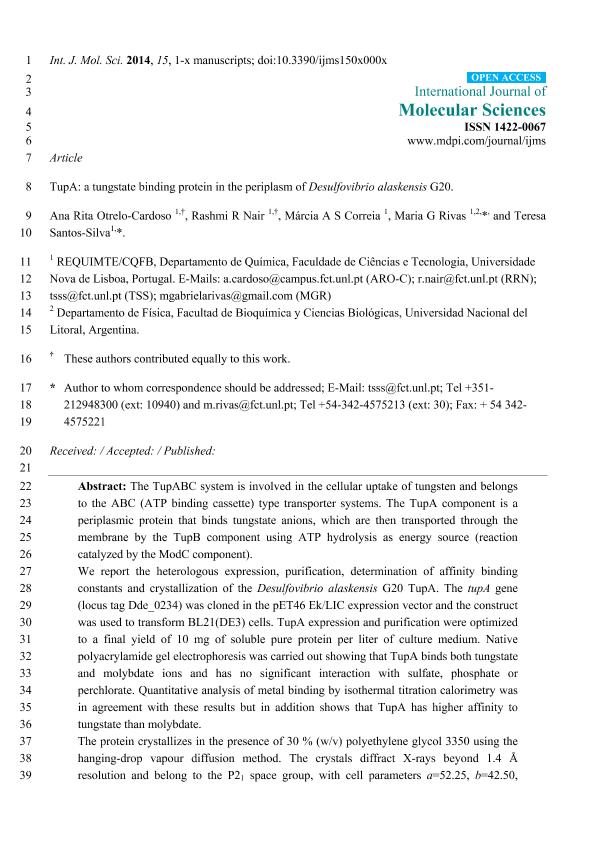Mostrar el registro sencillo del ítem
dc.contributor.author
Otrelo Cardoso, Ana Rita
dc.contributor.author
Nair, Rashmi
dc.contributor.author
Correia, Márcia
dc.contributor.author
Rivas, Maria Gabriela

dc.contributor.author
Santos Silva, Teresa
dc.date.available
2019-12-23T18:25:00Z
dc.date.issued
2014-07
dc.identifier.citation
Otrelo Cardoso, Ana Rita; Nair, Rashmi; Correia, Márcia; Rivas, Maria Gabriela; Santos Silva, Teresa; TupA: A tungstate binding protein in the periplasm of Desulfovibrio alaskensis G20; MDPI AG; International Journal of Molecular Sciences; 15; 7; 7-2014; 11783-11798
dc.identifier.issn
1422-0067
dc.identifier.uri
http://hdl.handle.net/11336/92833
dc.description.abstract
The TupABC system is involved in the cellular uptake of tungsten and belongs to the ABC (ATP binding cassette)-type transporter systems. The TupA component is a periplasmic protein that binds tungstate anions, which are then transported through the membrane by the TupB component using ATP hydrolysis as the energy source (the reaction catalyzed by the ModC component). We report the heterologous expression, purification, determination of affinity binding constants and crystallization of the Desulfovibrio alaskensis G20 TupA. The tupA gene (locus tag Dde_0234) was cloned in the pET46 Enterokinase/Ligation-Independent Cloning (LIC) expression vector, and the construct was used to transform BL21 (DE3) cells. TupA expression and purification were optimized to a final yield of 10 mg of soluble pure protein per liter of culture medium. Native polyacrylamide gel electrophoresis was carried out showing that TupA binds both tungstate and molybdate ions and has no significant interaction with sulfate, phosphate or perchlorate. Quantitative analysis of metal binding by isothermal titration calorimetry was in agreement with these results, but in addition, shows that TupA has higher affinity to tungstate than molybdate. The protein crystallizes in the presence of 30% (w/v) polyethylene glycol 3350 using the hanging-drop vapor diffusion method. The crystals diffract X-rays beyond 1.4 Å resolution and belong to the P21 space group, with cell parameters a = 52.25 Å, b = 42.50 Å, c = 54.71 Å, β = 95.43°. A molecular replacement solution was found, and the structure is currently under refinement.
dc.format
application/pdf
dc.language.iso
eng
dc.publisher
MDPI AG

dc.rights
info:eu-repo/semantics/openAccess
dc.rights.uri
https://creativecommons.org/licenses/by-nc-sa/2.5/ar/
dc.subject
TupA
dc.subject
tungstate
dc.subject
metal transport
dc.subject
Desulfovibrio
dc.subject
sulfate reducing bacteria
dc.subject
protein-ligand interaction
dc.subject
isothermal titration calorimetry
dc.subject
X-ray crystallography
dc.subject.classification
Bioquímica y Biología Molecular

dc.subject.classification
Ciencias Biológicas

dc.subject.classification
CIENCIAS NATURALES Y EXACTAS

dc.title
TupA: A tungstate binding protein in the periplasm of Desulfovibrio alaskensis G20
dc.type
info:eu-repo/semantics/article
dc.type
info:ar-repo/semantics/artículo
dc.type
info:eu-repo/semantics/publishedVersion
dc.date.updated
2019-12-20T21:13:34Z
dc.journal.volume
15
dc.journal.number
7
dc.journal.pagination
11783-11798
dc.journal.pais
Suiza

dc.journal.ciudad
Basel
dc.description.fil
Fil: Otrelo Cardoso, Ana Rita. Centro de Química Fina E Biotecnologia; Portugal
dc.description.fil
Fil: Nair, Rashmi. Centro de Química Fina E Biotecnologia; Portugal
dc.description.fil
Fil: Correia, Márcia. Centro de Química Fina E Biotecnologia; Portugal
dc.description.fil
Fil: Rivas, Maria Gabriela. Centro de Química Fina E Biotecnologia; Portugal. Universidad Nacional del Litoral; Argentina
dc.description.fil
Fil: Santos Silva, Teresa. Centro de Química Fina E Biotecnologia; Portugal
dc.journal.title
International Journal of Molecular Sciences

dc.relation.alternativeid
info:eu-repo/semantics/altIdentifier/doi/http://dx.doi.org/10.3390/ijms150711783
Archivos asociados
